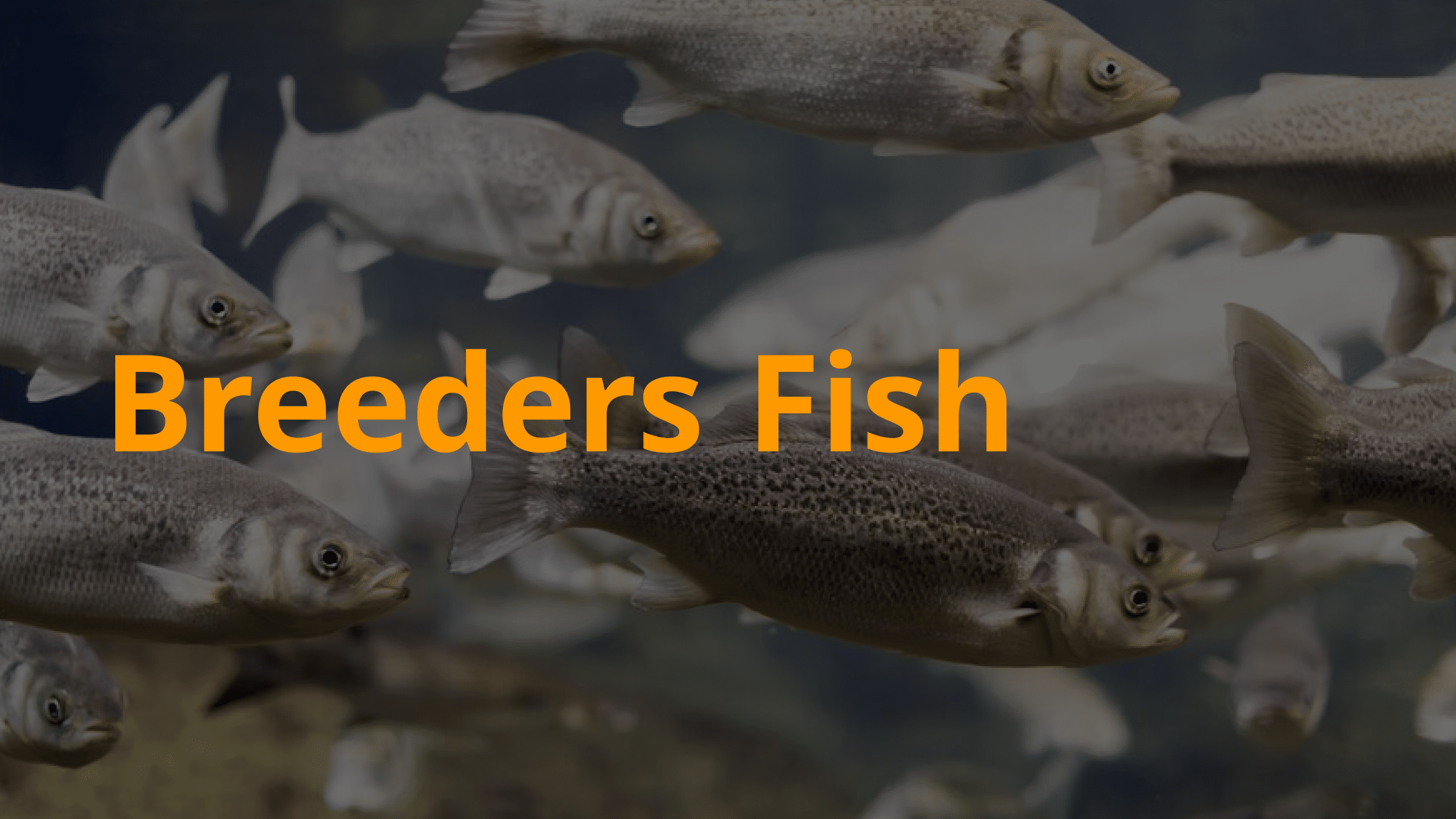Breeding fish isn’t just a hobby; it’s an art form. Learn the science behind successful breeding and discover the joy of raising baby fish with our in-depth guide to breeder’s fish. Explore their unique world and become a skilled breeder today.
Did you know that in the vast underwater world, breeding fish plays a crucial role in shaping life itself? These remarkable aquatic creatures are not your ordinary swimmers. They are the guardians of generations, the architects of survival, and the keepers of a hidden aquatic realm.
Breeder fish might look like regular fish when you see them in the water, but they are extraordinary parents. Their main job is to ensure their babies survive and grow up strong. They do this by caring for their little ones in remarkable ways. It’s almost like they have a secret world underwater.
In this article on breeders fish, we’ll learn how different breeder fish can be from one another, the clever things they do to have babies, and why they matter so much in the world beneath the water. So, come with us as we dive into the deep sea and discover the fascinating world of breeder’s fish.
What are breeder fish and their characteristics?
Breeder fish, also known as breeding fish or broodstock, play a pivotal role in the world of aquarium hobbyists and aquaculturists. They are carefully selected and maintained individuals of a particular fish species used to reproduce to ensure a consistent supply of fish for enthusiasts and commercial purposes.
Understanding the definition and characteristics of breeder fish is essential for those interested in fishkeeping. Here are some characteristics of breeder fish:
- Reproductive maturity
- Health and vitality
- Coloration and physical features
- Behavioral traits
- Compatibility
1. Reproductive maturity
One key characteristic of breeder fish is their reproductive maturity. This means they have reached the age and size at which they can produce offspring. It’s important to select fish that are old enough to breed successfully.
2. Health and vitality
Breeder fish should be in excellent health and exhibit vitality. Healthy breeders are more likely to produce strong and robust offspring, which is vital for the overall success of the breeding program.
3. Coloration and physical features
Some fish species exhibit specific coloration or physical features during their breeding season. Breeder fish of such species may display distinctive color patterns or develop certain physical traits that signal their readiness to reproduce.
4. Behavioral traits
Breeder fish often exhibit specific behavioral traits associated with courtship and reproduction. These behaviors include elaborate mating rituals, nest building, or guarding eggs and fry.
5. Compatibility
Compatibility between breeding pairs is crucial. The chosen breeders should be sexually compatible, meaning they consist of a male and female of the same species that can successfully mate and produce offspring.
Breeders fish vs. regular aquarium fish
Understanding how breeder fish differ from regular aquarium fish is essential for anyone interested in taking up breeding as a hobby or for commercial purposes. Breeder fish are distinct in several ways, setting them apart from the fish typically found in community aquariums. There are some things that differentiate breeder fish and aquarium fish.
- Specialized purpose
- Age and maturity
- Selective breeding
- Controlled environment
1. Specialized purpose
– Breeder fish are not kept for aesthetic purposes or to enhance the visual appeal of an aquarium, unlike regular aquarium fish. They are maintained specifically for their reproductive capabilities.
2. Age and maturity
– Breeder fish are typically older and more mature than their counterparts in community tanks. They have reached the age and size required for breeding, which may not be the case for regular aquarium fish.
3. Selective breeding
– The fishes used for breeding are carefully selected based on specific criteria, such as genetic traits, health, and reproductive potential. Regular aquarium fish are often chosen for their appearance, compatibility with other tank inhabitants, or ease of care.
4. Controlled environment
– Breeder fish are typically housed in controlled environments, such as breeding tanks, where conditions are optimized for successful reproduction. Regular aquarium fish are kept in a broader range of settings.
Best fish for breeding
Breeders favor certain fish species due to their ease of reproduction, market demand, or unique characteristics. These popular species serve as excellent examples of breeder fish.
- Guppies (Poecilia reticulata)
- Angelfish (Pterophyllum scalare)
- Betta fish (Betta splendens)
- Discus (Symphysodon spp.)
- Corydoras Catfish (Corydoras spp.)
1. Guppies (Poecilia reticulata)
– Guppies are known for their vibrant colors and prolific breeding habits. They are often used by beginners in fish breeding due to their relatively straightforward requirements.
2. Angelfish (Pterophyllum scalare)
– Angelfish are admired for their elegant appearance and are commonly bred for their distinctive fin patterns and color variations. They exhibit fascinating parental care behaviors.
3. Betta fish (Betta splendens)
– Betta fish, or Siamese fighting fish, are renowned for their stunning colors and long, flowing fins. They are popular among breeders for their ornamental qualities.
4. Discus (Symphysodon spp.)
– Discus fish are sought after for their unique disc-shaped bodies and vibrant colors. They require more specific care but are highly prized in the aquarium trade.
5. Corydoras Catfish (Corydoras spp.)
– Corydoras catfish are often used as breeder fish due to their peaceful nature and ability to thrive in community tanks. They are also valued for their role in controlling algae.
These popular breeder fish species offer diverse options for breeders, from beginner-friendly guppies to the more specialized care required for discus fish. Selecting the right breeder fish species depends on individual preferences, experience, and breeding goals.
How do you set up a breeding tank for fish?
Setting up a breeding tank is a critical step in successfully fish breeding . It involves creating an environment that mimics the natural habitat of the breeder fish species, promoting their comfort and reproductive behaviors. This section will delve into the detailed steps and considerations for setting up a breeding tank.
- Selecting an appropriate tank size
- Water parameters and temperature requirements
- Providing hiding spots and suitable substrate
- Equipment needed for a breeding tank
Selecting an appropriate tank size
Choosing the right tank size is paramount when establishing a breeding tank. The tank’s dimensions should suit the specific needs of your breeder fish species. Larger tanks generally offer more stability and space for fish to behave naturally.
- Research your species:
- Consider compatibility:
- Room for growth:
1. Research your species:
Different fish species have different space requirements. Investigate the size and recommended tank dimensions for your chosen breeder fish.
2. Consider compatibility:
If you plan to house multiple pairs or other tank inhabitants, ensure the tank size can accommodate them comfortably without causing stress or aggression.
3. Room for growth:
Keep in mind that as fry grows, they will require additional space. Factor in the eventual size of the offspring when selecting the tank size.
Water parameters and temperature requirements
Maintaining the right water conditions is crucial for the health and breeding success of your fish. The specific requirements can vary depending on the species, but some general considerations apply.
- Water temperature
- Water quality
- Filtration and aeration
1. Water temperature:
Research the ideal temperature range for your breeder fish species. Use a reliable aquarium heater to maintain stable temperatures.
2. Water quality:
Regularly test and monitor water quality parameters such as pH, ammonia, nitrites, and nitrates. Keep them within the acceptable range for your fish.
3. Filtration and aeration:
Install an appropriate aquarium filter to maintain water clarity and oxygenation. Many breeding tanks benefit from sponge filters, which provide gentle filtration and aeration.
C. Providing hiding spots and suitable substrate
Breeder fish often require specific hiding spots and substrate for breeding and raising their offspring.
- Cave or breeding cones
- Substrate selection
- Live plants
1. Cave or breeding cones:
Depending on your species, provide caves, hollow ornaments, or breeding cones where fish can lay their eggs or find refuge.
2. Substrate selection:
The choice of substrate can vary; some species prefer sand for egg-laying, while others may prefer fine gravel. Ensure it’s clean and free from sharp edges that could harm the fish or their fry.
3. Live plants:
Live aquatic plants not only enhance the aesthetic appeal of the tank but also serve as hiding places for fry and refuge for breeding pairs. Plants like Java moss and Amazon swords are popular choices.
D. Equipment needed for a breeding tank
Setting up a breeding tank requires some essential equipment to ensure your fish’s and their offspring’s well-being.
- Heater
- Thermometer
- Filter
- Lighting
- Air pump
- Water testing kit
- Net and siphon
- Lid or cover
1. Heater:
An adjustable aquarium heater is vital for maintaining stable water temperatures, especially for tropical fish species.
2. Thermometer:
Install a reliable thermometer to monitor water temperature accurately.
3. Filter:
Choose an appropriate filter, such as a sponge filter, to maintain water quality and circulation without creating strong currents that could harm fry.
4. Lighting:
Consider providing subdued lighting, as some fish species prefer dimmer conditions for breeding.
5. Air pump:
An air pump with an air stone or sponge filter attachment can provide additional aeration and circulation.
6. Water testing kit:
Invest in a water testing kit to regularly check and adjust water parameters as needed.
7. Net and siphon:
Keep a net for catching fish and a siphon for water changes and substrate cleaning handy.
8. Lid or cover:
Prevent fish from jumping out and ensure a secure environment by using a tank lid or cover.
By meticulously setting up your breeding tank with these considerations in mind, you create the ideal conditions for your breeder fish to thrive, reproduce, and raise healthy offspring. This attention to detail and dedication to creating a suitable environment greatly increase your chances of successful breeding.
How do you select breeders fish?
Selecting the right breeder fish is a pivotal step in the process of successful fish breeding. It involves a thoughtful consideration of compatibility, genetics, and the readiness of potential breeding pairs. In this section, we will explore the detailed aspects of selecting breeder fish.
a. Choosing compatible breeding pairs
- Species compatibility
- Behavioral compatibility
- Size and age
- Genetic diversity
- Health assessment
b. Factors to consider when selecting breeding stock
- Color and morphology
- Fertility
- Diet and nutrition
- Behavioral traits
- Record keeping
c. Recognizing signs of readiness to breed
- Color changes
- Courtship behavior
- Nesting or egg-laying behavior
- Egg production
- Mating behavior
A. Choosing compatible breeding pairs
1. Species compatibility:
Begin by ensuring that you have a male and female of the same species. Different species cannot interbreed, and attempting to do so will not yield viable offspring.
2. Behavioral compatibility:
Observe the behavior of your potential breeding pairs. Look for signs of aggression or stress. It’s essential that the selected individuals are not overly aggressive towards each other, as this can disrupt the breeding process.
3. Size and age:
Select fish that are of similar size and age. Mismatches in size can lead to difficulties during courtship and mating. Breeding fish of similar age can enhance reproductive success.
4. Genetic diversity:
Consider the genetic diversity within the breeding pair. Avoid inbreeding by ensuring that the individuals are not closely related. Inbreeding can lead to genetic deformities and health issues in the offspring.
5. Health assessment:
Examine the overall health of the potential breeders. Ensure they are free from visible signs of illness, parasites, or deformities. Healthy fish are more likely to produce healthy offspring.
B. Factors to consider when selecting breeding stock
1. Color and morphology:
Depending on your breeding goals, you may wish to select individuals with specific color patterns or unique morphological traits. Keep in mind that not all traits are hereditary, and selective breeding may be necessary.
2. Fertility:
Some fish may have a history of successful breeding, while others may struggle to produce viable offspring. Seek guidance from experienced breeders or consult species-specific resources to determine the fertility of potential breeders.
3. Diet and nutrition:
Prioritize individuals who have been well-fed and maintained on a balanced diet. Proper nutrition is critical for the health of both breeders and their offspring.
4. Behavioral traits:
Consider the natural behaviors of the species. Some fish may require specific conditions or cues to trigger breeding behavior. Understanding these behaviors can improve your breeding success.
5. Record keeping:
Keep thorough records of your breeding pairs, including their lineage, health history, and breeding outcomes. This information can be invaluable for future breeding efforts.
C. Recognizing signs of readiness to breed
1. Color changes:
Many fish species undergo color changes or become more vibrant during breeding periods. Observe any alterations in coloration, especially in males, as it can indicate readiness to breed.
2. Courtship behavior:
Breeding pairs often engage in courtship rituals, which can involve chasing, displaying, or fin-flaring. These behaviors are precursors to spawning.
3. Nesting or egg-laying behavior:
Some species build nests, while others may select specific locations for egg-laying. Recognize these behaviors as indications that breeding is imminent.
4. Egg production:
Female fish will develop a swollen abdomen when carrying eggs. This can be a visual cue that she is ready to lay eggs.
5. Mating behavior:
Witnessing the actual mating process, which can vary widely between species, is a definitive sign that your selected pair is ready to breed.
The selection of breeder fish is a crucial step in achieving successful breeding outcomes. Compatibility, genetic diversity, health, and the ability to recognize signs of readiness are key factors to consider. Thoughtful selection and meticulous observation will increase the likelihood of producing healthy offspring and a rewarding breeding experience.
What are the effective breeding techniques?
Breeding techniques play a pivotal role in ensuring the successful reproduction of your chosen breeder fish. These techniques encompass both natural methods, where fish follow their instincts, and artificial methods, which involve human intervention to optimize breeding outcomes.
1. Natural breeding methods
- Spawning behavior and cues
- Parental care
2. Artificial breeding techniques
- Inducing spawning
- Egg collection and incubation
- Rearing fry
Natural breeding methods
1. Spawning behavior and cues
Breeding pairs of fish often display specific spawning behaviors and cues that indicate their readiness to reproduce. Understanding these natural signs is essential for successful breeding.
– Courtship rituals: Many fish species engage in elaborate courtship rituals, including fin displays, chasing, and nipping. These behaviors create a bond between the male and female and are often precursors to spawning.
– Egg-laying site selection: Observing fish as they select suitable sites for egg-laying is a common sign of impending spawning. Some species lay their eggs on flat surfaces, while others prefer crevices or plant leaves.
– Egg fanning: After laying eggs, some species employ a parental care strategy where the male or female fans water over the eggs to provide oxygen and prevent fungal growth. This behavior is crucial for the survival of the developing embryos.
– Mating behavior: Mating behavior varies widely among species. It may involve the male fertilizing eggs externally or the female depositing eggs in a nest constructed by the male.
2. Parental care
Some breeder fish exhibit remarkable parental care behaviors, which contribute to the survival and growth of their offspring.
– Egg guarding: In species like cichlids, parents guard their eggs diligently, protecting them from potential threats and predators.
– Fry protection: After hatching, parental fish may continue to protect and care for their fry, providing shelter and food until the fry are self-sufficient.
B. Artificial breeding techniques
Artificial breeding techniques are employed when natural breeding is challenging or when specific breeding goals are desired.
1. Inducing spawning
– Hormone administration: In some cases, hormones may be administered to stimulate breeding behavior. Hormonal treatments mimic the natural hormonal changes that trigger spawning in the wild.
– Environmental manipulation: Altering environmental conditions such as temperature, lighting, and water chemistry can mimic the onset of the breeding season and encourage spawning.
2. Egg collection and incubation
– Egg collection: Breeding pairs may be monitored closely, and when eggs are laid, they are carefully collected to protect them from predation or fungal infections.
– Incubation chambers: Eggs are often transferred to specialized incubation chambers or containers with controlled water conditions to ensure their safety and development.
3. Rearing fry
– Separation: After hatching, fry are usually separated from adult fish to prevent predation. They are placed in rearing tanks or containers.
– Feeding: Providing appropriate food for fry is crucial for their growth. Newly hatched brine shrimp, microorganisms, or specialized fry food can be used.
– Water quality: Maintaining optimal water quality, including temperature, pH, and ammonia levels, is essential for the health and development of fry.
Breeding techniques encompass a range of natural and artificial methods designed to maximize breeding success while ensuring the well-being of both parent fish and their offspring. Understanding the specific behaviors and cues of your breeder fish species, as well as the application of artificial techniques when necessary, can significantly enhance your breeding endeavors.
Troubleshooting common issues while breeding fish
Breeding fish can be a fulfilling endeavor, but it is not without its challenges. Understanding how to address and mitigate common issues is essential for maintaining a successful breeding program.
A. Addressing breeding failures
- Evaluate compatibility
- Check water parameters
- Adjust diet
- Stress reduction
- Age and health
B. Dealing with aggressive breeding pairs
- Separation
- More hiding spots
- Adding distractors
- Selective breeding
C. Preventing disease outbreaks
- Quarantine new fish
- Maintain good hygiene
- Monitor water quality
- Isolate sick fish
- Consult a veterinarian
A. Addressing breeding failures
1. Evaluate compatibility:
If your breeding pairs fail to produce offspring, reevaluate their compatibility. Ensure they are of the same species and are not exhibiting aggressive or territorial behaviors that might inhibit breeding.
2. Check water parameters:
Incorrect water conditions can hinder breeding. Test and adjust water temperature, pH, and hardness to match the species’ requirements.
3. Adjust diet:
Ensure your breeder fish are receiving a well-balanced diet. Inadequate nutrition can lead to reproductive issues. Supplement their diet with high-quality foods and live or frozen treats.
4. Stress reduction:
Stress is a common factor in breeding failures. Minimize disturbances around the breeding tank, provide ample hiding spots, and avoid sudden changes in lighting or water flow.
5. Age and health:
Breeding pairs may take time to reach maturity or might have underlying health issues. Assess their overall health, and if necessary, replace them with healthier and more mature individuals.
B. Dealing with aggressive breeding pairs
1. Separation:
If you notice aggression between breeding pairs, consider temporarily separating them using dividers or additional tanks. Allow them to cool off before attempting to reintroduce them.
2. More hiding spots:
Increase the number of hiding spots and visual barriers within the breeding tank. This can help reduce confrontations and territorial disputes.
3. Adding distractors:
Introduce dither fish or other peaceful tank mates to divert the attention of aggressive breeders. This can reduce tension within the tank.
4. Selective breeding:
If aggression persists, you may need to choose different breeding pairs that are less prone to aggression or territorial behavior.
C. Preventing disease outbreaks
1. Quarantine new fish:
Before introducing new fish to your breeding program, quarantine them in a separate tank for a few weeks. This helps prevent the introduction of diseases to your established breeding population.
2. Maintain good hygiene:
Regularly clean and maintain your breeding tanks and equipment. Remove uneaten food, debris, and waste to prevent the buildup of harmful bacteria.
3. Monitor water quality:
Consistently monitor water parameters to ensure they remain within the acceptable range for your fish species. Poor water quality can stress fish and make them more susceptible to diseases.
4. Isolate sick fish:
If you notice signs of illness, isolate the affected fish promptly in a quarantine tank. This prevents the potential spread of disease to other fish.
5. Consult a veterinarian:
If disease outbreaks persist or are severe, consult with a veterinarian who specializes in fish health. They can provide expert advice and treatment options.
Addressing breeding failures, managing aggressive breeding pairs, and preventing disease outbreaks are integral aspects of successful fish breeding. By being proactive, observant, and making necessary adjustments, you can overcome common challenges and enjoy a thriving breeding program.
Breeding fish for profit or conservation
Breeding fish serves as a fascinating hobby and a means to achieve broader objectives, such as generating income through commercial breeding or contributing to the conservation efforts of endangered or rare species. In this section, we will delve into both aspects in detail.
A. Commercial breeding of ornamental fish
- Species selection
- Breeding facilities
- Efficient reproduction
- Disease management
- Market channels
B. Breeding endangered or rare species for conservation
- Species selection
- Research and planning
- Captive breeding
- Genetic diversity
- Release and monitoring
- Education and advocacy
- Legislation and protection
A. Commercial breeding of ornamental fish
Commercial breeding of ornamental fish has become a thriving industry, supplying pet stores and hobbyists with diverse, vibrant, and captivating fish species. Successful commercial breeding requires careful planning, infrastructure, and attention to market demands.
1. Species selection:
Commercial breeders carefully select species based on market demand and profitability. Popular choices include guppies, betta fish, and various cichlid species due to their appealing colors and patterns.
2. Breeding facilities:
Commercial breeding operations often utilize specialized facilities, including large breeding tanks, filtration systems, and controlled environments to optimize breeding conditions.
3. Efficient reproduction:
Breeders employ breeding techniques like hormone induction to maximize reproduction rates. They may also use selective breeding to enhance desirable traits.
4. Disease management:
Disease prevention and control are crucial to ensure the health of the breeding stock and prevent disease outbreaks that can lead to financial losses.
5. Market channels:
Commercial breeders establish distribution channels through pet stores, online sales, or direct supply to wholesalers. Market research helps identify the most lucrative avenues.
B. Breeding endangered or rare species for conservation
Breeding endangered or rare fish species for conservation purposes is a noble and essential endeavor. Many species face threats such as habitat destruction and overfishing, making captive breeding programs vital for their survival.
1. Species selection:
Conservationists prioritize species listed as endangered or critically endangered by organizations like the IUCN. Selection depends on the feasibility of captive breeding and potential reintroduction into the wild.
2. Research and planning:
In-depth research into the species’ biology, habitat requirements, and breeding behaviors informs the establishment of successful breeding programs.
3. Captive breeding:
Captive breeding programs are designed to mimic natural conditions as closely as possible. Specialized tanks, water conditions, and nutrition are provided to encourage breeding and healthy growth.
4. Genetic diversity:
To maintain genetic diversity, conservationists often collaborate with other institutions to exchange breeding stock. Genetic diversity is essential to prevent inbreeding and maintain the species’ health.
5. Release and monitoring:
When possible, bred individuals are reintroduced into their natural habitat. Monitoring programs track their progress, and ongoing support may be provided to ensure their survival.
6. Education and advocacy:
Conservation breeding programs often involve educational outreach to raise awareness about the plight of endangered species and promote their conservation.
7. Legislation and protection:
Conservation efforts are complemented by legal protections and international agreements aimed at preserving endangered species and their habitats.
Breeding for profit in the ornamental fish industry and breeding endangered or rare species for conservation are both significant endeavors. While the former contributes to the economy and the enjoyment of hobbyists, the latter is essential for preserving the biodiversity of our planet. Each approach requires dedication, expertise, and careful management to achieve its respective goals.
Disease prevention and treatment in breeding fish
Maintaining the health of your breeding fish and their offspring is paramount to a successful breeding program. Understanding common fish diseases, their symptoms, and how to prevent and treat them is essential for ensuring the well-being of your aquatic companions.
A. Common fish diseases and their symptoms
- Ich (White spot disease)
- Fin Rot
- Columnaris (Cotton wool disease)
- Dropsy
- Velvet Disease (Gold dust disease)
B. Preventive measures
- Quarantine procedures
- Water quality management
- Stress reduction
C. Identifying and treating common fish illnesses
- Early detection
- Isolation
- Consulting a veterinarian
- Medication treatment
- Hospital tank
1. Common fish diseases and their symptoms
Ich (White spot disease):
– Symptoms: White cysts or spots on fish’s skin, rapid gill movement, scratching against objects.
– Prevention: Maintain stable water conditions, avoid stress, and quarantine new fish.
Fin Rot:
– Symptoms: Torn or decaying fins, discolored edges, loss of fin tissue.
– Prevention: Ensure good water quality, avoid overcrowding, and provide a balanced diet.
Columnaris (Cotton wool disease):
– Symptoms: Grayish-white lesions on the skin, frayed fins, lethargy.
– Prevention: Maintain clean tanks, avoid overcrowding, and provide proper nutrition.
Dropsy:
– Symptoms: Swollen, bloated abdomen, raised scales, lethargy.
– Prevention: Maintain excellent water quality, avoid overfeeding, and quarantine new arrivals.
Velvet Disease (Gold dust disease):
– Symptoms: Tiny gold or rust-colored specks on the skin, rapid gill movement.
– Prevention: Keep stress levels low, ensure proper nutrition, and quarantine new fish.
2. Preventive measures
Quarantine procedures:
– Always quarantine new fish arrivals in a separate tank for at least two to four weeks.
– Monitor quarantined fish for signs of illness before introducing them to established tanks.
Water quality management:
– Maintain stable water parameters, including temperature, pH, and ammonia levels.
– Regularly test and perform water changes to ensure optimal conditions.
Stress reduction:
– Minimize stress factors such as abrupt changes in lighting, overcrowding, or handling.
– Provide hiding spots and a calm environment for your fish.
3. Identifying and treating common fish illnesses
Early detection:
– Regularly observe your fish for any unusual behavior, physical changes, or signs of distress.
– Look for changes in appetite, swimming patterns, and appearance.
Isolation:
– If you suspect a fish is sick, isolate it in a quarantine tank to prevent disease spread.
– This allows for close monitoring and reduces the risk of infecting other fish.
Consulting a veterinarian:
– Seek professional advice if you’re unsure about diagnosing or treating a fish illness.
– Veterinarians specializing in fish health can provide expert guidance and prescribe appropriate medications.
Medication treatment:
– Treat fish diseases with medications as recommended by a veterinarian or aquatic specialist.
– Follow dosage instructions carefully and complete the treatment regimen.
Hospital tank:
– Consider setting up a hospital tank for treating sick fish separately.
– Hospital tanks are easier to maintain and can reduce the risk of medication affecting other tank inhabitants.
Understanding and implementing effective disease prevention and treatment measures are essential for maintaining the health of your breeding fish. Regular monitoring, proper quarantine procedures, and prompt treatment can significantly prevent and manage common fish diseases, ensuring the well-being of your aquatic companions and the success of your breeding efforts.
Sustainable practices in commercial breeding
Commercial breeding of ornamental fish has experienced significant growth in recent years, driven by the demand for vibrant and diverse fish species in the aquarium trade. However, this expansion has raised concerns about its environmental impact. To address these concerns, the ornamental fish industry is increasingly adopting sustainable practices to ensure the long-term health of aquatic ecosystems and their species.
A. Highlighting the significance of sustainable practices
- Environmental impact
- Conservation value
- Ecosystem Integrity
- Market demand
B. Responsible sourcing of breeding stock
- Captive breeding priority
- Genetic diversity
- Selective breeding
C. Ethical considerations in the ornamental fish industry
- Animal welfare
- Transparency
- Regulatory compliance
- Education and outreach
Highlighting the significance of sustainable practices
1. Environmental impact:
The ornamental fish industry, like any other sector, has the potential to impact the environment negatively. Unsustainable practices can destroy habitat, overexploitation of wild populations, and water pollution.
2. Conservation value:
Many ornamental fish species are native to ecologically sensitive areas, such as tropical rainforests. Sustainable breeding practices help reduce the pressure on wild populations and contribute to their conservation.
3. Ecosystem Integrity:
Aquatic ecosystems are interconnected, and the removal of species from their natural habitats can disrupt these delicate balances. Sustainable breeding minimizes the need for collecting fish from the wild, which can harm local ecosystems.
4. Market demand:
As awareness of environmental issues grows, consumers are increasingly seeking out sustainably bred fish. This demand encourages the industry to adopt eco-friendly practices.
Responsible sourcing of breeding stock
1. Captive breeding priority:
Commercial breeders prioritize the propagation of fish through captive breeding rather than relying on wild-caught individuals. This helps preserve natural populations.
2. Genetic diversity:
Breeders work to maintain genetic diversity within their captive populations to prevent inbreeding and preserve the integrity of the species.
3. Selective breeding:
Selective breeding is used to enhance desirable traits within species, making them more attractive to consumers without negatively affecting their genetic diversity.
Ethical considerations in the ornamental fish industry
The ornamental fish industry has undergone significant transformation in recent years, with a growing emphasis on ethical practices.
In this section, we will take a closer look at ethical considerations in the ornamental fish industry, shedding light on how they contribute to sustainable and responsible fishkeeping practices.
1. Animal welfare
2. Transparency
3. Regulatory compliance
4. Education and outreach
1. Animal welfare:
Breeders are increasingly attentive to the welfare of their fish, ensuring proper housing, nutrition, and healthcare. Stress-free fish are healthier and more vibrant, appealing to consumers.
2. Transparency:
Ethical breeders provide clear information about the species they sell, including care requirements and potential size. This transparency helps customers make informed decisions about the suitability of a species for their aquarium.
3. Regulatory compliance:
Breeders adhere to local and international regulations governing the collection, breeding, and export of ornamental fish. Compliance ensures that practices are legal and sustainable.
4. Education and outreach:
Many breeders engage in educational outreach to promote responsible fishkeeping and raise awareness about environmental conservation.
Sustainable practices in commercial breeding are of paramount importance in the ornamental fish industry. By adopting responsible sourcing methods, minimizing environmental impact, and upholding ethical standards, breeders contribute to preserving aquatic ecosystems and the well-being of the species they cultivate. These practices benefit the environment and cater to consumers’ growing demand for ethically sourced ornamental fish.
Conclusion
Breeder fish, such as dolphins and sharks, may not be well-known, but they play a crucial role. They offer valuable insights into parenting, extending beyond the human realm to the aquatic world. They remind us that every life in our oceans and rivers is significant.
As we conclude our exploration of breeder fish, let’s keep these lessons in mind. We must care for our aquatic companions and safeguard the remarkable life beneath the waves. Whether you’re new to studying fish or an experienced enthusiast, there is always more to uncover in the fascinating world of breeder fish, full of surprises and wonders.
- “As chicaadmin at The Chicago Weekly, I curate trending national and international news stories with a focus on social justice and cultural impact. My passion for journalism and commitment to independent media are fueled by my Chicago roots and belief in the power of storytelling to connect communities. Follow me on Twitter for insightful commentary and news updates!”









